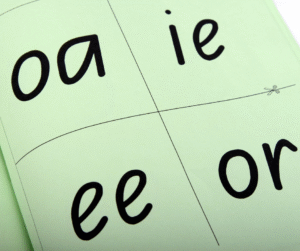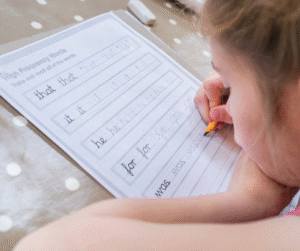Teaching writing can feel overwhelming when your child has a learning disorder that means they are not learning at the same pace as other kids. If writing is enough of a struggle, they may even have dysgraphia, the learning disability that is specific to writing. Dysgraphia can appear in many ways with many complicating factors. I am going to lay out the steps and stages of writing that are necessary for fluent writing and give you occupational therapy tips for making those steps easier. Depending on your child, some of these steps will be harder than others.
This is the list of what order I worry about learning to write. There are many skills needed to be a successful writer. Some kids can take off and do multiple steps at once, but for kids with dysgraphia, you will need to break the steps apart and work with more intention.
Handwriting
The first phase of writing is learning to write letters. For children that struggle with the fine motor skills, capital letters are easier to learn to make, as they have more straight lines and there is less confusion between D and B than d and b for most kids.
It is very important you not start working on handwriting until your child can hold a pencil properly. Before they can hold it the right way, in some form of tripod grip, they don’t have the motor skills needed for writing. Strengthening the hands and working on lots of fine motor activities will help them get there. One of my kids had to see an OT for a year (not me) to develop a mature pencil grip. It was worth it.
I highly recommend you spend some time on handwriting while your child is learning phonics. Put together making the letter with saying the sound. My Foundations and Fundamentals program is designed to work for this early phase.
Your child needs to know how to make every letter from memory before you go on from here. Doing multi-sensory activities often help kids learn letter formation. If they are really struggling, you can let them write in all capitals for a little while as they develop the ability to write in lower case. Some parents want to short-cut over to using a computer and typing. If your child has to keep up in a typical classroom, this may be necessary. However, if you are homeschooling, I recommend waiting until at least middle school to introduce typing assignments. Many colleges are pushing students to do more handwritten work, so working on handwriting is not time wasted.
In my house, I also circle back and teach cursive later, it often helps with handwriting and reinforces writing skills. I think it is highly debatable the right age to teach it, but I have found my kids were most receptive to it around early middle school.
Spelling
 The second phase of learning to write is learning to spell. For some kids, spelling is easy. They memorize what words look like and just put that on paper. For dysgraphic kids, it is often much harder. Some kids need to relearn phonics in the context of writing. Some need a lot of tactile experiences to help them memorize words.
The second phase of learning to write is learning to spell. For some kids, spelling is easy. They memorize what words look like and just put that on paper. For dysgraphic kids, it is often much harder. Some kids need to relearn phonics in the context of writing. Some need a lot of tactile experiences to help them memorize words.
For kids who struggle with ADHD, memorizing the spelling of words can also be challenging. There is not an age when spelling stops being important, so you may need to continue working on spelling skills through high school. I have seen that some kids eventually click with spelling and it gets easier in middle school, but that isn’t always the case.
I highly recommend having your child handwrite their spelling words, even if you don’t ask them to write anything else at this phase. The tactile experience of writing and practicing the spelling is best for brain development.
I have used many spelling programs over the years, they all have different pros and cons. I honestly feel my kids have benefited from the fact that we have switched programs as they grew so they got exposed to different methods. What works best at 8 may not be what works best at 12.
Grammar
I chose to work on grammar once a child is both able to read and able write enough words to make sentences. Trying to teach grammar before those skills have solidified is a waste of time, in my opinion. Grammar is only relevant in the context of writing so a good foundation in writing words and phrases is necessary.
I have three ways I like to teach grammar. First, I like copy work. Having a child copy sentences that have correct and interesting punctuation is a good way to introduce the skills of writing. Your child needs to be able to read all the words in their copy work, but you can introduce words they cannot spell. Start with simple sentences and point out the simple punctuation like periods, question marks and exclamation point. You can eventually move on to more complex punctuation like colons and quotation marks. If you need help finding good sentences, look at the books your child is reading or listening to for ones to copy.
Next, I work on identifying parts of speech. Some kids can learn this with a fun program like Mad Libs. However Winston Grammar was very helpful for one of my kids, as it explained each part of speech with no writing required. One thing to know, most school go over parts of speech every year for all of elementary school. If you wait until middle school, your student will likely pick it up more quickly and you can save yourself energy from teaching it over and over before they are ready to learn the material.
The most mature way I work on grammar, is to use programs that teach grammar through correction. In this case, I put the sentence on a white board and have my child correct the grammar of a sentence or paragraph with errors. This also requires minimal writing but teaches your child how to proof read, which they will need when they start writing longer assignments.
Writing
I choose not to push my kids to write for school work until they have the spelling and grammar skills they need to move forward with success. For my household, this means that we don’t start writing assignments before middle school and don’t write essays before high school.
While in elementary school, we work on developing good verbal skills, because those lay the foundation for good writing. I read passages and ask my kids to tell me back what they heard. I read them a history lesson and they have to answer questions about it. We discuss the books they read and the movies we watch. They learn to how to verbally tell a story and explain what they like. If your child can’t do those things verbally, they are very hard write down.
Once my kids are ready to put together their writing skills, we work on dictation, as in I say something and they copy it down. This can be part of a spelling or grammar program, but the idea is that they hear a sentence and then hold it in their head long enough to write it down.
Next, we work on reading passages and writing summaries of them. This is a skill necessary for college level work, so I consider it to be very important. Can you read a passage and write down the important parts? This skill might happen in middle or high school for the student with dysgraphia, depending on how well all the other skills are coming along.
After that, comes writing answers to questions about the passages they read and sharing their opinion. It is important students start to answer complex questions that are not part of what they read. “Do you think the hero made a good choice?” or “Did you agree with the moral of this story?” This is also essential to being able to write essays in college.
Last, we actually learn the parts of an essay and write actual essays and research papers. I teach these skills in 11th or 12th grade. You may feel shocked I teach them so late, but who needs those skills before college? That is where these skills are needed for most students. So we prepare for college once it is in sight.
I hope this is helpful for those homeschooling a child with dysgraphia. The important thing to know is that your child needs to be able to write by graduation, not by third grade.







0 Comments